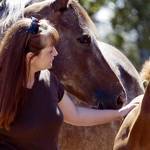Avoid Bites from Horses

Anyone who has spent time around horses has noticed that these animals have a lot of big teeth, and many horse owners can tell stories about being on the wrong end of those enormous incisors. Horses use their teeth in mutual grooming, in disciplining foals and weanlings, in play with their pasturemates, and against other horses in aggression or defense. Young horses use their mouths and teeth in the same way human babies do, exploring the taste and texture of everything they see.
As they mature, most horses become somewhat less “mouthy,” though many stallions are inclined to bite and some must even be muzzled for safety while they are being handled. A stallion is fully capable of grabbing a full-grown man in his teeth, lifting him off the ground, and shaking him hard before throwing him down. This aggressive behavior may come with little or no warning.
Bites are among the less frequent human injuries caused by horses, with only about 3 to 5% of the 100,000 yearly equine-related emergency room visits being due to bite-related accidents. These injuries can be severe, however, ranging from simple lacerations, through loss of skin and flesh, all the way to amputation of fingers, ears, or noses. Severe bruising, torn connective tissue, and fractures are also possible results of being bitten by a horse. There is a risk of infection any time the skin is broken by an animal bite, including those caused by an equine. Horses can spread viruses including Hendra, rabies, vesicular stomatitis, and equine influenza through a bite wound. Bacteria such as those that cause tetanus, MRSA, and other staphylococcal or rhodococcal infections infections can also be transmitted.
Obviously, biting is something that should be discouraged, and this training should be established by anyone who handles young horses. Mares don’t allow biting and kicking from their foals, and human handlers must enforce the same rules. Punish inappropriate behavior by delivering a sharp slap to the shoulder with the flat of the hand. Loudly tell the foal “no” or “bad,” and walk away. Don’t worry if the foal acts a little scared or sulky; he’ll get the message. Screaming and physical abuse are not called for, just firm, consistent discipline.
Be careful not to let anti-bite training become a game. Foals bite each other and then duck away before the victim can return the bite. Handlers who try to slap a foal’s mouth may be buying into the same game and actually encouraging biting. One suggested response to continued nuzzling and biting is for the handler to respond by holding the foal’s halter with one hand and using the knuckles of the other hand to rub the muzzle area firmly enough to cause mild discomfort for a few seconds.
Be aware that although most horses won’t do so, any horse can bite. Until you get acquainted with a horse that’s new to you, pay attention when you are handling it and don’t put yourself in a position where you can be bitten. Bites from any animal should be washed with soap and water, and medical attention should be gotten for serious bites. All animal bites are required to be reported to a local health department.








